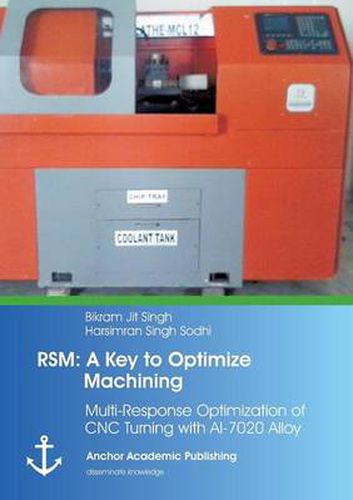Readings Newsletter
Become a Readings Member to make your shopping experience even easier.
Sign in or sign up for free!
You’re not far away from qualifying for FREE standard shipping within Australia
You’ve qualified for FREE standard shipping within Australia
The cart is loading…






This title is printed to order. This book may have been self-published. If so, we cannot guarantee the quality of the content. In the main most books will have gone through the editing process however some may not. We therefore suggest that you be aware of this before ordering this book. If in doubt check either the author or publisher’s details as we are unable to accept any returns unless they are faulty. Please contact us if you have any questions.
Parametric optimization, especially in machining of non-ferrous alloys seems to be quite rare and needs an immediate attention because of its associated downstream financial and non-financial losses. This book tries to fill the gap and presents an optimization problem of commonly used Al-7020 Alloy. Principles of Response Surface Methodology (RSM) have been implemented through Minitab software to bring necessary multi-response optimization, while turning on a CNC turner. The present study focuses on to enhance Material Removal Rate (MRR) while simultaneously reducing the Surface Roughness (Ra), during turning of Al-alloy. Such opposite natured response optimization is much difficult to achieve, particularly when uncoated carbide tip has been used as a cutting tool. Intensive literature survey helps to pin point parameters like; Cutting Speed, Feed Rate and Depth of Cut as a most critical to machining parameters, as far as effective and efficient optimization of selected responses are concerned. All these control-parameters are directly or inversely related to each other. If the depth of cut is increased MRR increases at the same time we get poor surface finish. Increase in the cutting speed has positive impact on both material removal rate and surface finish. Shortlisted parameters are conflicting, so we have to optimize these for further enhancement of the overall turning performance. At last, the optimized results are verified by using ANOVA as a statistical tool. This book provides quite rare Case-study of multi-response optimization (while non-ferrous CNC turning) to practioners, machinists and SME owners appropriately.
$9.00 standard shipping within Australia
FREE standard shipping within Australia for orders over $100.00
Express & International shipping calculated at checkout
This title is printed to order. This book may have been self-published. If so, we cannot guarantee the quality of the content. In the main most books will have gone through the editing process however some may not. We therefore suggest that you be aware of this before ordering this book. If in doubt check either the author or publisher’s details as we are unable to accept any returns unless they are faulty. Please contact us if you have any questions.
Parametric optimization, especially in machining of non-ferrous alloys seems to be quite rare and needs an immediate attention because of its associated downstream financial and non-financial losses. This book tries to fill the gap and presents an optimization problem of commonly used Al-7020 Alloy. Principles of Response Surface Methodology (RSM) have been implemented through Minitab software to bring necessary multi-response optimization, while turning on a CNC turner. The present study focuses on to enhance Material Removal Rate (MRR) while simultaneously reducing the Surface Roughness (Ra), during turning of Al-alloy. Such opposite natured response optimization is much difficult to achieve, particularly when uncoated carbide tip has been used as a cutting tool. Intensive literature survey helps to pin point parameters like; Cutting Speed, Feed Rate and Depth of Cut as a most critical to machining parameters, as far as effective and efficient optimization of selected responses are concerned. All these control-parameters are directly or inversely related to each other. If the depth of cut is increased MRR increases at the same time we get poor surface finish. Increase in the cutting speed has positive impact on both material removal rate and surface finish. Shortlisted parameters are conflicting, so we have to optimize these for further enhancement of the overall turning performance. At last, the optimized results are verified by using ANOVA as a statistical tool. This book provides quite rare Case-study of multi-response optimization (while non-ferrous CNC turning) to practioners, machinists and SME owners appropriately.